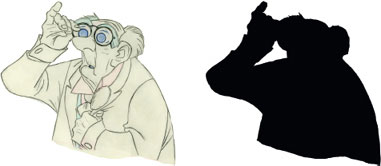Line, of course, is what we must use to delineate our drawings. Silhouette is a test of whether or not the lines have successfully depicted the pose.
To draw a shape with a single line with no shading or texture means we must tell the whole story with line alone. The line has to explain the action, as well as what is happening to the structure as it performs that action — what is beneath the clothing or the fur or the skin.
A line drawing may have all the necessary parts and props but not pass the silhouette test. This simply means the drawing should have been staged to read more clearly, even if it were to be completely blacked in.
A “line” drawing actually is a “shape” drawing, as the silhouette test shows. One does not animate lines, but shapes. Lines merely make it possible to depict shapes and to convert those shapes into squashes and stretches, lateral and foreshortened drawings, straights and curves, etc.
A variety of lines will add to a shape’s interest and persuasiveness. For instance, curved against straight, short against long, heavy against fine.
A judicious use of thick and thin will add texture to the drawing and further the illusion of third dimension — heavy lines to imply shadows; thicker lines to suggest eyelashes in contrast to the delicate line of the eye orb. Thick lines on parts closest to the viewer tend to make them seem closer, again adding to the much desired third dimensional effect.
The term “touchup” originated on 101 Dalmatians. In an attempt to retain the spontaneous qualities of the animation ruffs, the drawings were merely shorn of superfluous action and construction lines. Also the backgrounds had a Xeroxed line drawing placed over them, simulating the line drawings of the animation. It was a successful marriage of animation and background.
For the time being, we have of necessity gone back to cleaning up the drawings, but are still attempting to retain the spontaneous qualities of the animators ’ drawings. Although cleanup usually implies a slick drawing with faultless line quality, it certainly should still have the looseness and pliability of the original, plus the solidarity of a well-constructed drawing. In the end, there is no such thing as an animated drawing as opposed to a cleanup drawing; they are one and the same and should be treated so.

